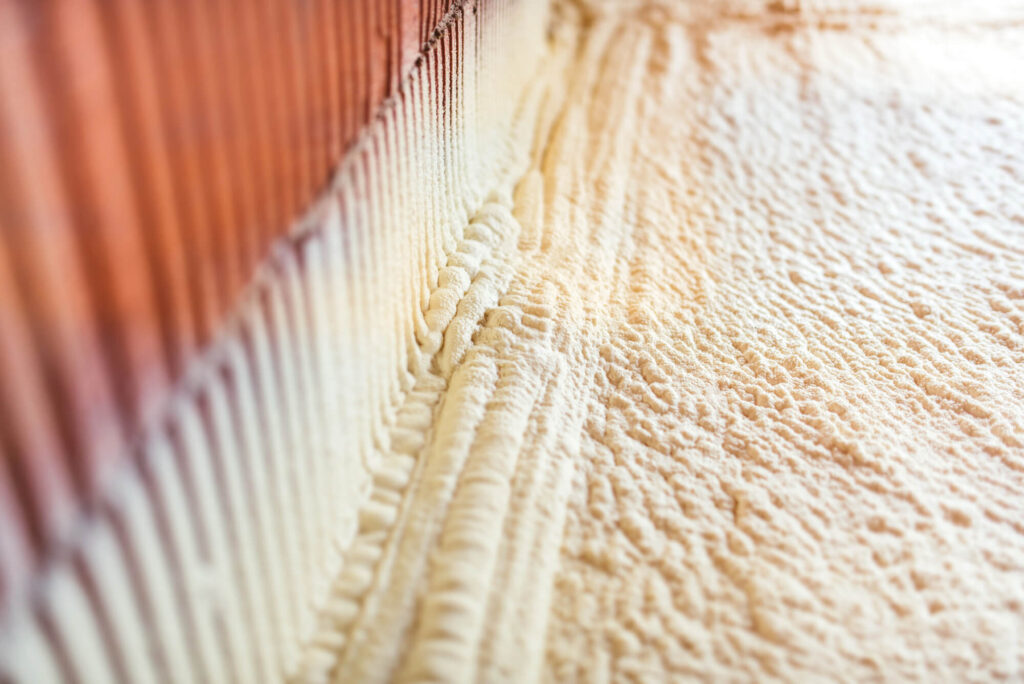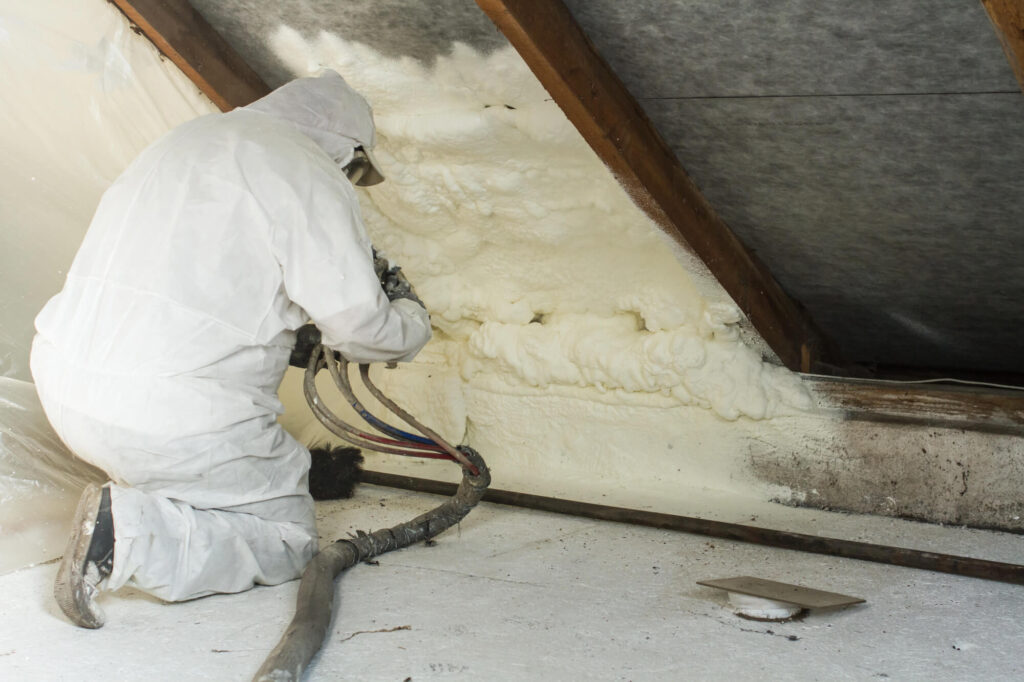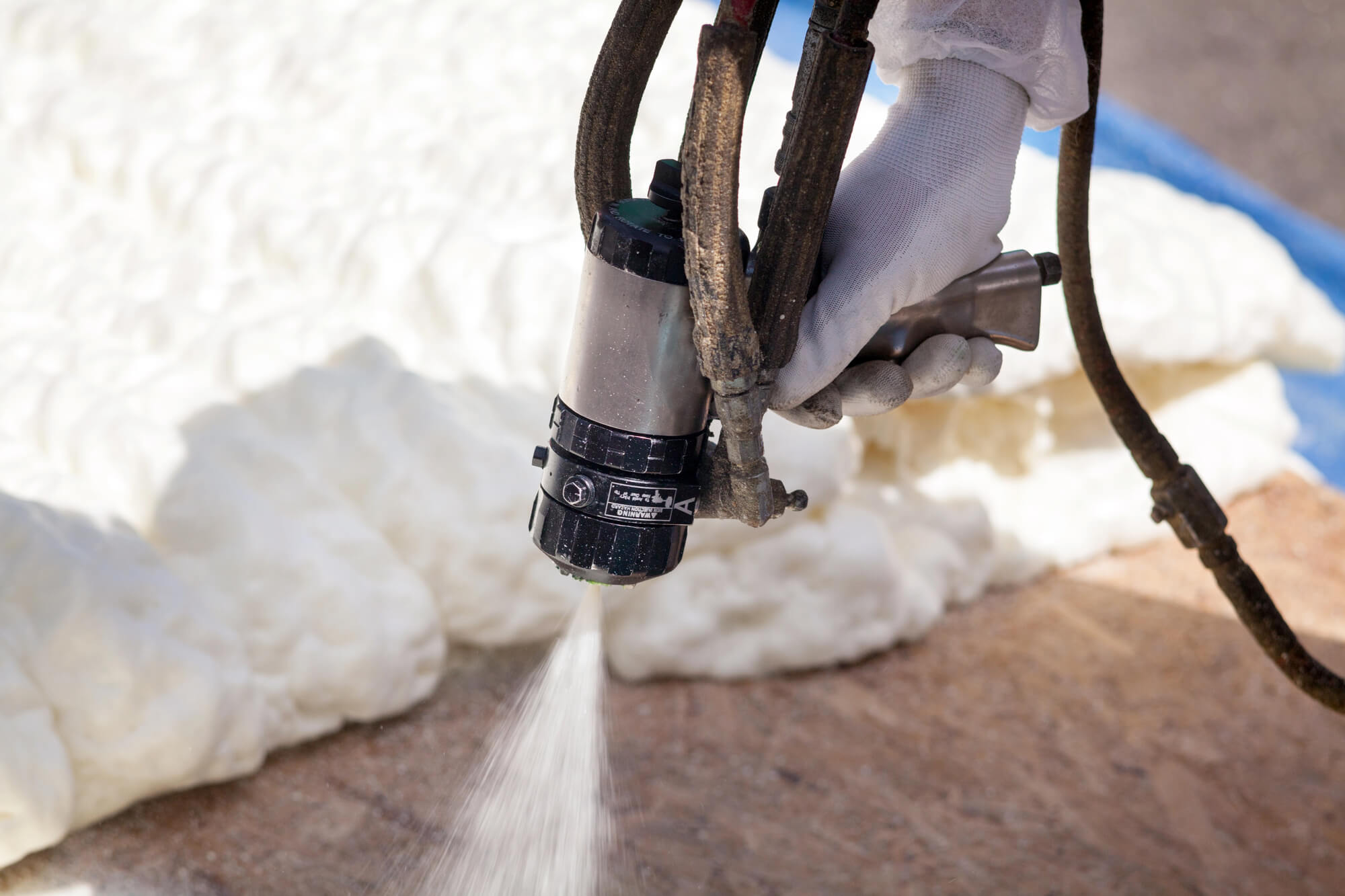Spray foam insulation is one of the most effective ways to enhance the energy efficiency of a home or commercial building. Known for its airtight seal and superior insulation properties, spray foam spreads over every square foot of your walls to prevent heat loss, reduce energy bills, and improve indoor air quality.
As a trusted leader in the insulation industry, iFOAM, a HorsePower Brands company, provides high-quality spray foam insulation tailored to homes and businesses.
With this detailed guide, we’ll cover factors that affect the cost of spray foam insulation, how it compares to other insulation types, and how you can get an estimate from iFOAM professionals.
What Is Spray Foam Insulation?
Spray foam insulation is a highly effective and modern insulation method that provides excellent thermal resistance, air sealing, and moisture control. Unlike traditional insulation materials, one of the main benefits of spray foam is that it expands upon application, filling cracks, crevices, and hard-to-reach spaces.
Spray foam insulation is made from polyurethane foam insulation, which forms when isocyanate and polyol resin react. Once applied, it expands, filling gaps and creating a moisture barrier that enhances thermal resistance.
- How It Works: The liquid components are sprayed onto a surface, where they expand to form a seamless insulation layer, preventing heat loss and condensation.
- Energy Efficiency: Unlike fiberglass insulation or blown-in insulation, spray foam effectively seals cracks and gaps, reducing energy costs.
The Two-Component System
This common type of foam insulation consists of two key components: an “A” side and a “B” side, which are stored separately in drums before application.
- The “A” side typically contains methylene diphenyl diisocyanate (MDI) and polymeric methylene diphenyl diisocyanate (pMDI). These chemicals are highly reactive and play a crucial role in the foam’s expansion and curing process.
- The “B” side is a blend of polyols, catalysts, a blowing agent, flame retardant, and surfactant. This layer determines the foam’s density, flexibility, and overall insulation properties.
When mixed, these components undergo a significant chemical transformation, rapidly expanding and curing to form a durable insulation layer.
Types of Spray Foam Insulation
Open-Cell Spray Foam
Open-cell spray foam insulation is a lightweight, flexible insulator that expands significantly upon application. Its structure creates tiny air pockets that contribute to effective thermal and sound insulation.
- Expansion and Flexibility: The foam expands up to 100 times its liquid volume, filling in hard-to-reach areas and forming an airtight seal.
- Cost-Effectiveness: Open-cell foam uses fewer materials per square foot, making it a more budget-friendly option.
- Breathability: Unlike closed-cell foam, open-cell spray foam allows for moisture permeability, reducing the risk of trapped condensation.
- R-Value: ~R-3.5 to R-4 per inch, making it effective for interior applications like walls and ceilings.
Closed-Cell Spray Foam
Closed-cell spray foam is a denser, more rigid insulation option that offers superior thermal insulation and moisture resistance.
- High Density and Strength: Closed-cell spray foam has a compact structure that adds to the structural integrity of walls and ceilings.
- Water Resistance: Functions as a vapor barrier, making it ideal for areas prone to moisture exposure, such as basements and crawl spaces.
- Energy Efficiency: Provides a higher R-value per inch than open-cell foam, making it an excellent choice for exterior walls and commercial buildings to lower energy costs.
- Long-Term Savings: While the initial cost per board foot is higher, the superior insulation properties of closed-cell spray foam lead to long-term energy savings.
- R-Value: ~R-6 to R-7 per inch, making it one of the most efficient insulation options available.

Factors That Influence Spray Foam Insulation Costs
The entire project cost of an insulation installation depends on multiple cost factors, from the foam type used to labor cost and material costs. Knowing what the average cost comes from and keeping them in mind will help homeowners and businesses make informed decisions when choosing the best types of insulation solutions for their needs.
Below, we break down the key considerations that impact spray foam insulation costs.
Types of Spray Foam Used
The types of spray foam used, open-cell and closed-cell, play a major role in determining the cost of insulation. As we already established above, open-cell foam is more affordable due to its lightweight and lower density, making it ideal for interior applications. Closed-cell foam, on the other hand, offers superior insulation and moisture resistance but comes at a higher cost per board foot. Additionally, the required thickness, regardless of the foam type, affects pricing, as thicker applications require more material and labor.
R-Value
R-value is a crucial measure of an insulation material’s thermal resistance. Higher R-values indicate greater insulation efficiency, but they also contribute to increased costs. Closed-cell insulation foam has a significantly higher R-value than open-cell foam, making it more effective for extreme climates where energy savings are a priority. Additionally, regional climates tend to determine building codes that may dictate the required R-value, impacting the overall cost of installation.
Home Size and Application Area
The size of the home or building and the square feet being insulated significantly affect the total cost. Larger spaces require more material, increasing the expense. Insulating specific areas, such as attic spaces, crawl spaces, exterior walls, or garages, can also represent additional costs depending on accessibility and structural complexity. Homes with higher ceilings or extensive square footage will naturally have higher insulation project costs.
Labor Cost and Installation Complexity
The complexity of the installation process is another important factor in determining cost. Homes with difficult-to-reach spaces, such as high ceilings or intricate layouts, may require specialized equipment and additional labor expenses, meaning extra cost overall. Professional installation is recommended to ensure proper application and optimal energy efficiency. DIY spray foam insulation kits may seem cost-effective, but improper spray foam installation can lead to air gaps and energy inefficiency, ultimately costing more in the long run. And without the proper protective gear, you risk injury to yourself and other house residents.
Geographic Location
The cost of spray foam insulation varies depending on geographic location. Urban areas tend to have higher labor costs than rural regions due to increased demand for professional contractors. Additionally, local material availability and shipping expenses can influence the price of insulation projects. Climate can also impact spray foam costs, as homes in extreme temperatures may require more insulation to meet energy efficiency standards.
Existing Insulation Removal
If a home already has existing insulation, it, along with the drywall and wiring, may need to be removed before applying spray foam. This is often necessary when upgrading from fiberglass insulation or blown-in cellulose insulation to ensure a clean and effective installation. The process of removing old insulation from a house adds disposal and labor costs to the project, which can increase the total price. Some building departments may require removal before installing spray foam to comply with safety and efficiency regulations.
Material Quality and Brand
The quality of the spray foam material itself is another factor in pricing. Not all types of spray foams are created equal—some contain lower-quality components that may degrade over time, reducing insulation effectiveness. iFOAM exclusively uses premium materials that provide superior longevity, energy efficiency, and durability. Choosing a trusted brand ensures that the insulation in your house will perform well for years, reducing the likelihood of needing costly repairs or replacements.
Spray Foam Insulation vs. Other Insulation Types: A Cost-Benefit Comparison
Choosing the right insulation type is essential for optimizing energy efficiency and long-term cost savings. Spray foam insulation stands out due to its superior air-sealing capabilities, but how does it compare to other common insulation types? Below, we explore the key differences in cost, performance, and longevity.
Table Comparing by Type of Insulation
| Insulation Type | Cost Range per Square Feet | R-Value per Inch | Lifespan | Energy Efficiency |
| Spray Foam (Open-Cell) | $$ | R-3.5 to R-4 | 20+ years | High |
| Spray Foam (Closed-Cell) | $$$ | R-6 to R-7 | 30+ years | Very High |
| Fiberglass BATT | $ | R-2.9 to R-3.8 | 15-20 years | Moderate |
| Blown-In Cellulose | $$ | R-3.1 to R-3.8 | 20-30 years | Moderate |
| Rigid Foam Board | $$-$$$ | R-4 to R-6 | 30+ years | High |
Energy Efficiency Considerations
Spray foam insulation is one of the most energy-efficient insulation options available. Unlike fiberglass insulation, which can allow air to pass through gaps, spray foam creates a tight air seal that minimizes heat loss. This reduces the amount of energy required to heat or cool a building, leading to lower energy bills. Additionally, closed-cell foam enhances structural integrity, offering both insulation and reinforcement in a single application, making it a preferred choice for exterior walls and high-performance buildings.
Improving Indoor Air Quality
Because it creates an airtight seal, it prevents outdoor contaminants from entering the home, making it particularly beneficial for individuals with allergies or respiratory conditions. Additionally, spray foam insulation acts as a vapor barrier, as it prevents external humidity from seeping in, reducing the risk of mold growth and promoting a healthier indoor environment. However, professional installation is the only one that can guarantee a tight air seal with spray foam or any other insulation product.
Sustainable Insulation Choice
Its durability means it does not need to be replaced as often, leading to less material waste over time. As a result, homeowners looking for a sustainable insulation solution may find spray foam to be a worthwhile investment.
Longevity & ROI
Although spray foam insulation has a higher upfront cost than traditional insulation, its long-term benefits make it a cost-effective investment. With superior insulation performance, homeowners experience lower energy bills year after year. Additionally, because spray foam insulation lasts for decades without degrading, it reduces the need for frequent replacements, offering long-term savings on maintenance and a strong return on investment over the lifespan of a home or building.
Moisture & Mold Prevention
One of the key advantages of spray foam insulation, particularly closed-cell spray foam insulation, is its ability to act as a moisture barrier. Unlike other traditional insulation methods like fiberglass, which can absorb moisture and become a breeding ground for mold, spray foam resists water infiltration. . This makes it ideal for areas prone to high humidity, such as basements and crawl spaces, helping to prevent long-term water damage and improving overall indoor air quality.

Why Opt for Professional Spray Foam Installation?
When considering spray foam insulation for your home, opting for a professional contractor can ensure optimal performance and lasting results. Among the available services, iFOAM stands out, offering expert knowledge and exceptional craftsmanship.
Here’s why choosing iFOAM for your insulation needs is a decision worth making.
- Expert Installation Ensures Optimal Energy Efficiency: iFOAM’s skilled contractors guarantee correct application,, maximizing thermal insulation effectiveness and energy savings.
- Full Range of Insulation Services: Beyond spray foam, iFOAM offers a comprehensive suite of services, including:
- Attic insulation
- BATT insulation
- Air sealing solutions
- Commercial insulation services
- Supported by the HorsePower Brands Franchise Network: Benefit from a nationally recognized and trusted network combined with local expertise. Discover your nearest iFOAM location.
How to Get an Estimate for Your Home
- Consult a Local iFOAM Expert: Get a customized assessment based on your project size and insulation materials.
Steps to Get a Quote:
- Schedule a free consultation.
- Discuss home insulation needs and energy efficiency goals.
- Receive a tailored estimate from iFOAM insulation contractors.
Whatever the Type of Foam or Project Size, Trust iFOAM
Spray foam insulation is an investment that pays off through increased energy efficiency, lower utility bills, and a more comfortable indoor environment. Whether you are looking to insulate a new home, upgrade existing insulation on an existing home, or protect your property from moisture and mold in every square foot possible, this type of insulation is a superior choice.
Choosing iFOAM means choosing professional installation, premium materials, and long-lasting insulation solutions. With expert guidance and a commitment to quality, iFOAM ensures a successful insulation project that delivers optimal results.
If you’re ready to improve your home’s insulation and enjoy the long-term benefits of spray foam, contact iFOAM professionals today. Schedule a consultation and find out how we can enhance your property’s or home’s energy efficiency and overall comfort.





